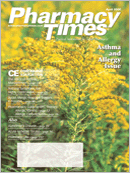Publication
Article
Pharmacy Times
Avoiding Allergic-Reaction Triggers
Author(s):
Millions of Americans suffer from allergies. According to the National Institute of Allergy and Infectious Diseases, an allergy is defined as a specific reaction of the body's immune system to a normally harmless substance. People who experience allergic reactions often are prone to being sensitive to more than one substance.
Allergies can be classified into several different categories, such as inhaled allergies, food allergies, medication allergies, and skin allergies. Oftentimes, it is difficult to distinguish between an allergy and a cold, because both exhibit symptoms of runny nose, sneezing, and coughing (Table 1). The only way for patients to know for sure whether they have an allergy or a cold is for them to consult a health care provider.
Types of Allergies
Most people who suffer from allergies become sensitized to proteins found in such items as latex, pollen, certain fruits, and drugs. If the reaction to these allergens involves the entire body, it is called a systemic reaction. Systemic reactions (also known as anaphylaxis) may lead to further complications such as anaphylactic shock, where the entire body shuts down.
Common sources of inhaled allergies include insects, dust mites, and pollen from plants. These types of inhaled allergens are common not only in the United States, but also worldwide.
Dust mites can be found in various places, including pillows, rugs, soft toys, upholstered furniture, clothes, mattresses, and bedsheets. In both adults and children, it is believed that 65% to 90% of all asthma cases are due to dust mites. Mites need moisture and human dander for survival and growth. In order to reduce exposure to this inhaled allergen, one must take certain preventive steps, such as putting pillows and mattresses in allergen-impermeable covers, keeping rugs out of bedrooms, washing soft toys at least once a week, limiting the number of soft toys a child may sleep with, and trying not to lie down or sleep on upholstered furniture.
Contrary to popular beliefs, these mites can be found in virtually any home, regardless of levels of cleanliness or economic status. In order to kill dust mites, it is recommended that all individuals affected by inhaled allergens wash bedsheets and pillow cases frequently with water temperatures >130?F.
Pollen from plants also is a very common source of allergens, with people experiencing symptoms more during the change of seasons (ie, fall and spring). In particular, ragweed, grass, flowers, and even common houseplants can trigger an allergic reaction.
Insects and animals may contribute to allergy symptoms. Cockroaches, which can shed their body parts and drop waste, may act as a trigger for allergies. Pets, such as dogs and cats, may shed loose hair or skin, resulting in exposure to pet dander.
Food allergies may be mild to lifethreatening. People have been found to be allergic to just about anything. Yet, some food allergies are more common than others, such as allergies to peanuts, shellfish, fish, eggs, fruits, preservatives, dyes, and spices. Symptoms can range from sore throat, numbness around the mouth, cough, and itchiness to anaphylaxis, which can be deadly. Patients should avoid the offending foods whenever possible and always carry epinephrine (eg, EpiPen Auto-Injector) if they suffer from severe food allergies. If, at any time, swelling of the lips, tongue, or difficulty in breathing is experienced, patients must visit an emergency room immediately.
Skin allergies are common with wool, dust, cosmetics, soaps, metals, and plant exposure (eg, poison ivy). A reaction may be immediate or prolonged after exposure.
Treatment of Allergies
The most important principle to remember in considering treatment is to avoid known allergens whenever possible. Unfortunately, doing so is often difficult, and patients may not realize until it is too late that they have been exposed to an allergen. Many treatments for allergies (Table 2) can be purchased without a prescription. They are packaged in the form of lotions, creams, ointments, syrups, pills, inhalers, and injectables. The pharmacist should refer a patient to a physician if the condition needs special attention and/or a prescription medication.
Several types of medications are used to treat allergies. The most common are antihistamines, corticosteroids, decongestants, mast cell stabilizers, and, in cases of anaphylaxis, epinephrine (Table 2).
Antihistamines
Antihistamines typically are used to relieve itching of the skin, nose, or eyes. They will help reduce nasal swelling and drainage to reduce sneezing. Side effects include drowsiness, dry mouth, and possibly constipation. While taking antihistamines,patients should be sure to stay well hydrated and avoid any activity that requires full attention. Antihistamines may interact with other medications, particularly those that cause sedation.
Topical Nasal Steroids
Topical nasal steroids often are used to relieve inflammation in the nasal passages in order to help breathing. Side effects are mild and include dryness of the nasal passages, sneezing, and stinging. Prolonged use may lead to worsening of symptoms. Patients always should use these products as directed.
Conclusion
Certain allergic-reaction triggers (pollen, latex, certain foods, and certain drugs) have been identified as problemprone. Patients need to understand which allergens affect them and to avoid those substances when possible. When an allergic reaction takes place, however, several OTC medications are available. Pharmacists should know when it is most advantageous for patients to use an OTC medication and when they should be referred to a doctor. If the attack makes patients' lips or tongue swell, makes breathing difficult, or makes blood pressure drop, patients should go immediately to an emergency room.
Ms Ng is a PharmD candidate at the Arnold & Marie Schwartz College of Pharmacy and Health Sciences, Long Island University. Dr. Pham is an assistant professor of pharmacy practice at the same institution.
For a list of sugested reading, send a stamped, self-addressed envelope to: References Department, Attn. A. Stahl, Pharmacy Times, 241 Forsgate Drive, Jamesburg, NJ 08831; or send an e-mail request to: [email protected].

Newsletter
Stay informed on drug updates, treatment guidelines, and pharmacy practice trends—subscribe to Pharmacy Times for weekly clinical insights.






